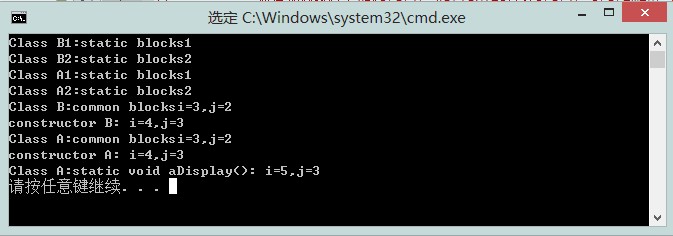
This is actually an Alibaba written test question I encountered during school recruitment last year (admit it’s a bit old -.-), well, if I remember correctly, it was an optional major question in the direction of Java. . Of course, the meaning of the question is not so straightforward. The question only requires you to write the output results of all System.out.println after the program is run. The program is given by the question, and the different execution order of each System.out.println will lead to the final program output. The results are also different.
I definitely can’t remember the specific question, but we can ask it in a direct way, if there are static variables, static statement blocks, non-static variables, non-static statement blocks, and constructors in class A and class B , static method, non-static method, and class A inherits class B. When instantiating A, what is the loading order inside the class?
I was also confused at the time, and I wrote one myself afterwards. After a small demo, I now know the actual loading sequence inside the class. The test code is as follows:
Class B:
public class B{ //静态变量 static int i=1; //静态语句块 static { System.out.println("Class B1:static blocks"+i); } //非静态变量 int j=1; //静态语句块 static{ i++; System.out.println("Class B2:static blocks"+i); } //构造函数 public B(){ i++; j++; System.out.println("constructor B: "+"i="+i+",j="+j); } //非静态语句块 { i++; j++; System.out.println("Class B:common blocks"+"i="+i+",j="+j); } //非静态方法 public void bDisplay(){ i++; System.out.println("Class B:static void bDisplay(): "+"i="+i+",j="+j); return ; } //静态方法 public static void bTest(){ i++; System.out.println("Class B:static void bTest(): "+"i="+i); return ; } }
Class A:
public class A extends B{ //静态变量 static int i=1; //静态语句块 static { System.out.println("Class A1:static blocks"+i); } //非静态变量 int j=1; //静态语句块 static{ i++; System.out.println("Class A2:static blocks"+i); } //构造函数 public A(){ super(); i++; j++; System.out.println("constructor A: "+"i="+i+",j="+j); } //非静态语句块 { i++; j++; System.out.println("Class A:common blocks"+"i="+i+",j="+j); } //非静态方法 public void aDisplay(){ i++; System.out.println("Class A:static void aDisplay(): "+"i="+i+",j="+j); return ; } //静态方法 public static void aTest(){ i++; System.out.println("Class A:static void aTest(): "+"i="+i); return ; } }
Class ClassLoading:
public class ClassLoading { public static void main (String args[]) { A a=new A(); a.aDisplay(); } }
The program running result is as shown in the figure:

Through the above diagram, we can clearly see the entire loading process of the java class.
1. If you want to load class A, first load and execute the static variables and static statement blocks of its parent class B (Object) (the order of execution is in the order of arrangement).
2. Then load the static variables and static statement blocks of execution class A. (And steps 1 and 2 will only be executed once)
3. If you need to instantiate class A, first call the constructor of its parent class B, and before calling the constructor of its parent class B, call it in sequence. Non-static variables and non-static statement blocks in parent class B. Finally, call the constructor in parent class B to initialize.
4. Then call the non-static variables and non-static statement blocks in class A in sequence. Finally, call the constructor in A for initialization. (And steps 3 and 4 can be repeated)
5. Static methods and non-static methods are both passive calls, that is, the system will not automatically call and execute them, so they will not be executed when the user does not call them. The main difference is that static methods It can be called directly using the class name (or instantiated objects), while non-static methods can only be called after the object is instantiated.
OK, that’s all for today. If there is anything that is not good or wrong, you are welcome to point it out and I will correct it. Thank you.
For more related articles on the loading order analysis of classes in Java (commonly used in interview questions), please pay attention to the PHP Chinese website!




